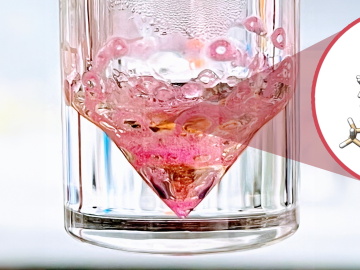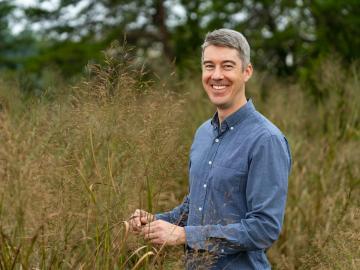Filter News
Area of Research
- Advanced Manufacturing (20)
- Biological Systems (3)
- Biology and Environment (135)
- Biology and Soft Matter (4)
- Building Technologies (9)
- Chemical and Engineering Materials (4)
- Chemistry and Physics at Interfaces (7)
- Clean Energy (339)
- Climate and Environmental Systems (11)
- Computational Biology (2)
- Computational Chemistry (5)
- Computational Engineering (3)
- Computer Science (13)
- Data (1)
- Earth Sciences (1)
- Electricity and Smart Grid (2)
- Energy Frontier Research Centers (7)
- Energy Sciences (2)
- Fossil Energy (1)
- Fuel Cycle Science and Technology (2)
- Functional Materials for Energy (8)
- Fusion and Fission (37)
- Fusion Energy (15)
- Geographic Information Science and Technology (1)
- Isotope Development and Production (2)
- Isotopes (27)
- Materials (211)
- Materials for Computing (23)
- Materials Synthesis from Atoms to Systems (8)
- Materials Under Extremes (7)
- Mathematics (1)
- National Security (54)
- Neutron Data Analysis and Visualization (4)
- Neutron Science (109)
- Nuclear Science and Technology (47)
- Nuclear Systems Modeling, Simulation and Validation (2)
- Quantum Condensed Matter (3)
- Quantum information Science (7)
- Renewable Energy (4)
- Sensors and Controls (4)
- Supercomputing (196)
- Transportation Systems (6)
News Type
Date
News Topics
- 3-D Printing/Advanced Manufacturing (70)
- Advanced Reactors (22)
- Artificial Intelligence (59)
- Big Data (40)
- Bioenergy (65)
- Biology (75)
- Biomedical (40)
- Biotechnology (15)
- Buildings (41)
- Chemical Sciences (32)
- Clean Water (28)
- Climate Change (72)
- Composites (15)
- Computer Science (125)
- Coronavirus (29)
- Critical Materials (14)
- Cybersecurity (17)
- Decarbonization (57)
- Education (1)
- Emergency (2)
- Energy Storage (65)
- Environment (150)
- Exascale Computing (26)
- Fossil Energy (4)
- Frontier (26)
- Fusion (40)
- Grid (45)
- High-Performance Computing (54)
- Hydropower (11)
- Irradiation (2)
- Isotopes (32)
- ITER (5)
- Machine Learning (33)
- Materials (75)
- Materials Science (83)
- Mathematics (7)
- Mercury (10)
- Microelectronics (2)
- Microscopy (34)
- Molten Salt (6)
- Nanotechnology (32)
- National Security (40)
- Net Zero (9)
- Neutron Science (76)
- Nuclear Energy (76)
- Partnerships (15)
- Physics (35)
- Polymers (19)
- Quantum Computing (21)
- Quantum Science (38)
- Renewable Energy (1)
- Security (13)
- Simulation (35)
- Software (1)
- Space Exploration (22)
- Statistics (1)
- Summit (36)
- Sustainable Energy (89)
- Transformational Challenge Reactor (3)
- Transportation (67)
Media Contacts

ORNL researchers and communications specialists took part in the inaugural AI Expo for National Competitiveness in Washington D.C, May 7 and 8, to showcase and provide insight into how the lab is leading the way for utilizing the vast possibilities of AI.

A team from ORNL successfully characterized a coordination complex of the element Promethium. The research was supported by computational simulations of the element's electronic structure run on the IBM AC922 Summit supercomputer.

The United States has enough biomass potential to produce 35 billion gallons per year of aviation biofuel by 2050, a new report confirms. ORNL’s John Field provided biomass feedstock production expertise to the report focused on the role of the bioeconomy in U.S. decarbonization strategies.

Oak Ridge National Laboratory scientists ingeniously created a sustainable, soft material by combining rubber with woody reinforcements and incorporating “smart” linkages between the components that unlock on demand.

Early career scientist Frankie White's was part of two major isotope projects at the same time he was preparing to be a father. As co-lead on a team that achieved the first synthesis and characterization of a radium compound using single crystal X-ray diffraction and part of a team that characterized the properties of promethium, White reflects on the life-changing timeline at work, and at home.

John Lagergren, a staff scientist in Oak Ridge National Laboratory’s Plant Systems Biology group, is using his expertise in applied math and machine learning to develop neural networks to quickly analyze the vast amounts of data on plant traits amassed at ORNL’s Advanced Plant Phenotyping Laboratory.

Momentum for manufacturing innovation in the United States got a boost during the inaugural MDF Innovation Days, held recently at the U.S. Department of Energy Manufacturing Demonstration Facility at Oak Ridge National Laboratory.

ORNL scientists develop a sample holder that tumbles powdered photochemical materials within a neutron beamline — exposing more of the material to light for increased photo-activation and better photochemistry data capture.

ORNL researchers used electron-beam additive manufacturing to 3D-print the first complex, defect-free tungsten parts with complex geometries.

A technology developed by Oak Ridge National Laboratory works to keep food refrigerated with phase change materials, or PCMs, while reducing carbon emissions by 30%.




